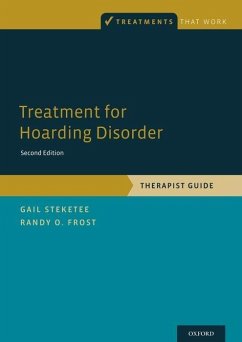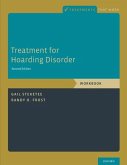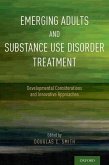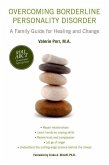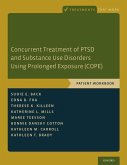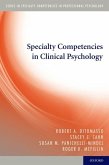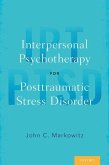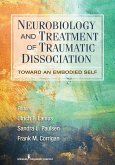- Broschiertes Buch
- Merkliste
- Auf die Merkliste
- Bewerten Bewerten
- Teilen
- Produkt teilen
- Produkterinnerung
- Produkterinnerung
This Second Edition of Treatment for Hoarding Disorder is the culmination of more than 20 years of research on understanding hoarding and building an effective intervention to address its myriad components.
Andere Kunden interessierten sich auch für
![Treatment for Hoarding Disorder (Workbook) Treatment for Hoarding Disorder (Workbook)]() Gail SteketeeTreatment for Hoarding Disorder (Workbook)43,99 €
Gail SteketeeTreatment for Hoarding Disorder (Workbook)43,99 €![Emerging Adults and Substance Use Disorder Treatment Emerging Adults and Substance Use Disorder Treatment]() Emerging Adults and Substance Use Disorder Treatment61,99 €
Emerging Adults and Substance Use Disorder Treatment61,99 €![Overcoming Borderline Personality Disorder Overcoming Borderline Personality Disorder]() Valerie PorrOvercoming Borderline Personality Disorder35,99 €
Valerie PorrOvercoming Borderline Personality Disorder35,99 €![Concurrent Treatment of Ptsd and Substance Use Disorders Using Prolonged Exposure (Cope) Concurrent Treatment of Ptsd and Substance Use Disorders Using Prolonged Exposure (Cope)]() Sudie E BackConcurrent Treatment of Ptsd and Substance Use Disorders Using Prolonged Exposure (Cope)45,99 €
Sudie E BackConcurrent Treatment of Ptsd and Substance Use Disorders Using Prolonged Exposure (Cope)45,99 €![Specialty Competencies in Clinical Psychology Specialty Competencies in Clinical Psychology]() Robert A. DitomassoSpecialty Competencies in Clinical Psychology66,99 €
Robert A. DitomassoSpecialty Competencies in Clinical Psychology66,99 €![Interpersonal Psychotherapy for Posttraumatic Stress Disorder Interpersonal Psychotherapy for Posttraumatic Stress Disorder]() John C. MarkowitzInterpersonal Psychotherapy for Posttraumatic Stress Disorder52,99 €
John C. MarkowitzInterpersonal Psychotherapy for Posttraumatic Stress Disorder52,99 €![Neurobiology and Treatment of Traumatic Dissociation Neurobiology and Treatment of Traumatic Dissociation]() Ulrich F. LaniusNeurobiology and Treatment of Traumatic Dissociation115,99 €
Ulrich F. LaniusNeurobiology and Treatment of Traumatic Dissociation115,99 €-
-
-
This Second Edition of Treatment for Hoarding Disorder is the culmination of more than 20 years of research on understanding hoarding and building an effective intervention to address its myriad components.
Hinweis: Dieser Artikel kann nur an eine deutsche Lieferadresse ausgeliefert werden.
Hinweis: Dieser Artikel kann nur an eine deutsche Lieferadresse ausgeliefert werden.
Produktdetails
- Produktdetails
- Verlag: OUP US
- Seitenzahl: 278
- Erscheinungstermin: 1. November 2013
- Englisch
- Abmessung: 254mm x 178mm x 15mm
- Gewicht: 529g
- ISBN-13: 9780199334964
- ISBN-10: 019933496X
- Artikelnr.: 39123607
- Herstellerkennzeichnung
- Books on Demand GmbH
- In de Tarpen 42
- 22848 Norderstedt
- info@bod.de
- 040 53433511
- Verlag: OUP US
- Seitenzahl: 278
- Erscheinungstermin: 1. November 2013
- Englisch
- Abmessung: 254mm x 178mm x 15mm
- Gewicht: 529g
- ISBN-13: 9780199334964
- ISBN-10: 019933496X
- Artikelnr.: 39123607
- Herstellerkennzeichnung
- Books on Demand GmbH
- In de Tarpen 42
- 22848 Norderstedt
- info@bod.de
- 040 53433511
Dr. Gail Steketee is Dean and Professor at the Boston University School of Social Work. Her scholarly work has focused on developing and testing treatments for obsessive compulsive spectrum disorders, especially hoarding symptoms in recent years. Dr. Steketee has published over 200 articles and chapters, and over a dozen books on these topics, including therapist guides, client workbooks, edited volumes, and self-help books on hoarding and related conditions. She gives frequent lectures, workshops, and media interviews on hoarding and related conditions to professional and public audiences in the U.S. and abroad. Dr. Randy O. Frost is the Israel Professor of Psycholo at Smith College and an international expert on hoarding a related phenomena. He has published over 150 scientific articles and book chapters on these topics. Dr. Frost has co-authored several books on hoarding and was awarded the Lifetime Achievement Award for excellence in innovation, treatment, and research in the field of hoarding and cluttering by the Mental Health Association of San Francisco. He gives frequent lectures, workshops, and media interviews on the topic of hoarding a related conditions.
Chapter 1 Introduction to Hoarding Disorder
Chapter 2 Evidence-based Treatment for Hoarding Disorder
Chapter 3 Assessing Hoarding
Chapter 4 Case Formulation
Chapter 5 Enhancing Motivation
Chapter 6 Planning Treatment
Chapter 7 Reducing Acquiring
Chapter 8 Training Skills
Chapter 9 Making Decisions about Saving and Discarding
Chapter10 Cognitive Strategies
Chapter 11 Complications in the Treatment of Hoarding Disorder
Chapter 12 Maintaining Gains
Appendix Forms and Assessments
1. Clinician Session Form
2. Hoarding Interview
3. Hoarding Rating Scale
4. Saving Inventory - Revised (SI-R)
5. Clutter Image Rating (CIR)
6. Saving Cognitions Inventory (SCI)
7. Activities of Daily Living for Hoarding (ADL-H)
8. Safety Questions
9. Home Environment Inventory (HEI)
10. Scoring keys for assessment instruments
11. Blank Model of Hoarding
12. Brief Thought Record
13. Acquiring Form
14. Clutter Visualization Form
15. Unclutter Visualization Form
16. Acquiring Visualization Form
17. Practice Form
18. Thought Record
19. Instructions for Coaches
20. Family Response to Hoarding Scale (FRHS)
References
Readings and Resources
About the Authors
Index
Chapter 2 Evidence-based Treatment for Hoarding Disorder
Chapter 3 Assessing Hoarding
Chapter 4 Case Formulation
Chapter 5 Enhancing Motivation
Chapter 6 Planning Treatment
Chapter 7 Reducing Acquiring
Chapter 8 Training Skills
Chapter 9 Making Decisions about Saving and Discarding
Chapter10 Cognitive Strategies
Chapter 11 Complications in the Treatment of Hoarding Disorder
Chapter 12 Maintaining Gains
Appendix Forms and Assessments
1. Clinician Session Form
2. Hoarding Interview
3. Hoarding Rating Scale
4. Saving Inventory - Revised (SI-R)
5. Clutter Image Rating (CIR)
6. Saving Cognitions Inventory (SCI)
7. Activities of Daily Living for Hoarding (ADL-H)
8. Safety Questions
9. Home Environment Inventory (HEI)
10. Scoring keys for assessment instruments
11. Blank Model of Hoarding
12. Brief Thought Record
13. Acquiring Form
14. Clutter Visualization Form
15. Unclutter Visualization Form
16. Acquiring Visualization Form
17. Practice Form
18. Thought Record
19. Instructions for Coaches
20. Family Response to Hoarding Scale (FRHS)
References
Readings and Resources
About the Authors
Index
Chapter 1 Introduction to Hoarding Disorder
Chapter 2 Evidence-based Treatment for Hoarding Disorder
Chapter 3 Assessing Hoarding
Chapter 4 Case Formulation
Chapter 5 Enhancing Motivation
Chapter 6 Planning Treatment
Chapter 7 Reducing Acquiring
Chapter 8 Training Skills
Chapter 9 Making Decisions about Saving and Discarding
Chapter10 Cognitive Strategies
Chapter 11 Complications in the Treatment of Hoarding Disorder
Chapter 12 Maintaining Gains
Appendix Forms and Assessments
1. Clinician Session Form
2. Hoarding Interview
3. Hoarding Rating Scale
4. Saving Inventory - Revised (SI-R)
5. Clutter Image Rating (CIR)
6. Saving Cognitions Inventory (SCI)
7. Activities of Daily Living for Hoarding (ADL-H)
8. Safety Questions
9. Home Environment Inventory (HEI)
10. Scoring keys for assessment instruments
11. Blank Model of Hoarding
12. Brief Thought Record
13. Acquiring Form
14. Clutter Visualization Form
15. Unclutter Visualization Form
16. Acquiring Visualization Form
17. Practice Form
18. Thought Record
19. Instructions for Coaches
20. Family Response to Hoarding Scale (FRHS)
References
Readings and Resources
About the Authors
Index
Chapter 2 Evidence-based Treatment for Hoarding Disorder
Chapter 3 Assessing Hoarding
Chapter 4 Case Formulation
Chapter 5 Enhancing Motivation
Chapter 6 Planning Treatment
Chapter 7 Reducing Acquiring
Chapter 8 Training Skills
Chapter 9 Making Decisions about Saving and Discarding
Chapter10 Cognitive Strategies
Chapter 11 Complications in the Treatment of Hoarding Disorder
Chapter 12 Maintaining Gains
Appendix Forms and Assessments
1. Clinician Session Form
2. Hoarding Interview
3. Hoarding Rating Scale
4. Saving Inventory - Revised (SI-R)
5. Clutter Image Rating (CIR)
6. Saving Cognitions Inventory (SCI)
7. Activities of Daily Living for Hoarding (ADL-H)
8. Safety Questions
9. Home Environment Inventory (HEI)
10. Scoring keys for assessment instruments
11. Blank Model of Hoarding
12. Brief Thought Record
13. Acquiring Form
14. Clutter Visualization Form
15. Unclutter Visualization Form
16. Acquiring Visualization Form
17. Practice Form
18. Thought Record
19. Instructions for Coaches
20. Family Response to Hoarding Scale (FRHS)
References
Readings and Resources
About the Authors
Index

